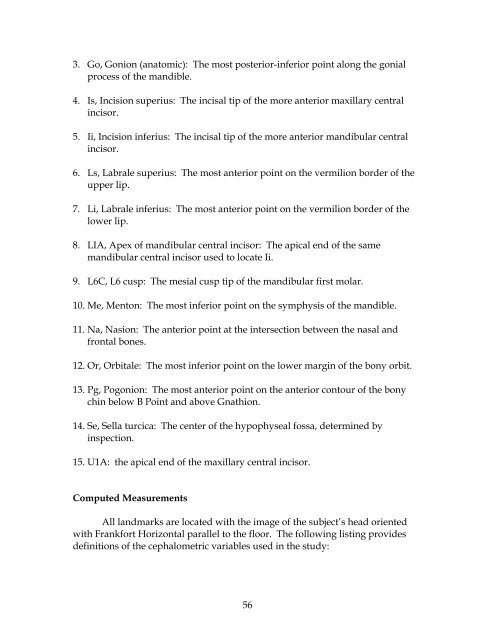EFFICACY OF TEMPORARY FIXED RETENTION FOLLOWING ...
EFFICACY OF TEMPORARY FIXED RETENTION FOLLOWING ...
EFFICACY OF TEMPORARY FIXED RETENTION FOLLOWING ...
Create successful ePaper yourself
Turn your PDF publications into a flip-book with our unique Google optimized e-Paper software.
3. Go, Gonion (anatomic): The most posterior-inferior point along the gonial<br />
process of the mandible.<br />
4. Is, Incision superius: The incisal tip of the more anterior maxillary central<br />
incisor.<br />
5. Ii, Incision inferius: The incisal tip of the more anterior mandibular central<br />
incisor.<br />
6. Ls, Labrale superius: The most anterior point on the vermilion border of the<br />
upper lip.<br />
7. Li, Labrale inferius: The most anterior point on the vermilion border of the<br />
lower lip.<br />
8. LIA, Apex of mandibular central incisor: The apical end of the same<br />
mandibular central incisor used to locate Ii.<br />
9. L6C, L6 cusp: The mesial cusp tip of the mandibular first molar.<br />
10. Me, Menton: The most inferior point on the symphysis of the mandible.<br />
11. Na, Nasion: The anterior point at the intersection between the nasal and<br />
frontal bones.<br />
12. Or, Orbitale: The most inferior point on the lower margin of the bony orbit.<br />
13. Pg, Pogonion: The most anterior point on the anterior contour of the bony<br />
chin below B Point and above Gnathion.<br />
14. Se, Sella turcica: The center of the hypophyseal fossa, determined by<br />
inspection.<br />
15. U1A: the apical end of the maxillary central incisor.<br />
Computed Measurements<br />
All landmarks are located with the image of the subject’s head oriented<br />
with Frankfort Horizontal parallel to the floor. The following listing provides<br />
definitions of the cephalometric variables used in the study:<br />
56
















